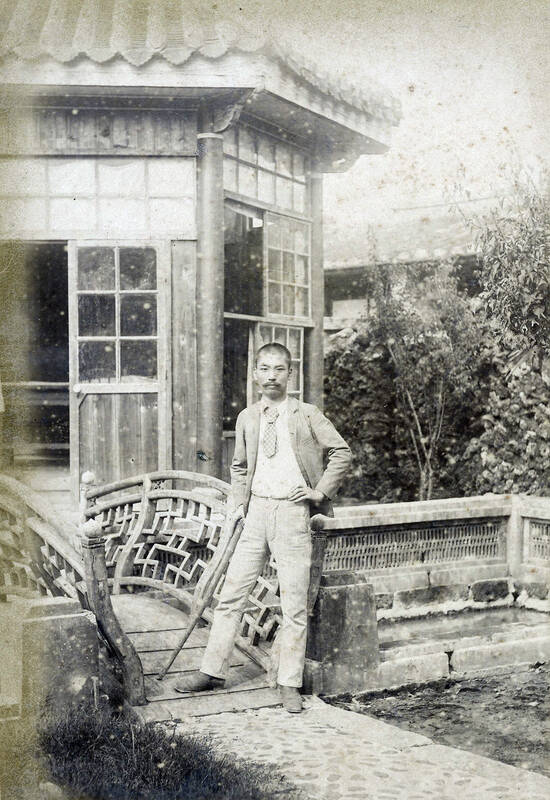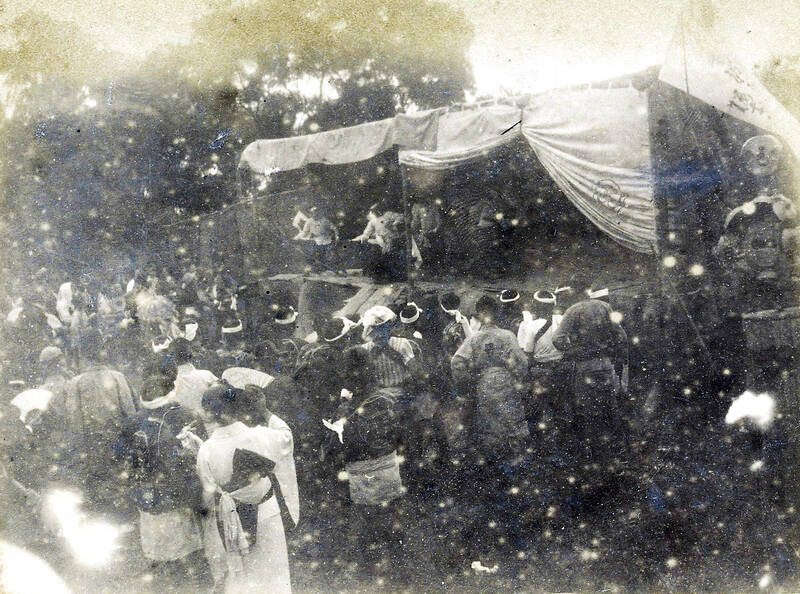June 9 to June 15
A photo of two men riding trendy high-wheel Penny-Farthing bicycles past a Qing Dynasty gate aptly captures the essence of Taipei in 1897 — a newly colonized city on the cusp of great change.
The Japanese began making significant modifications to the cityscape in 1899, tearing down Qing-era structures, widening boulevards and installing Western-style infrastructure and buildings.

Photo courtesy of National Center of Photography and Images
The photographer, Minosuke Imamura, only spent a year in Taiwan as a cartographer for the governor-general’s office, but he left behind a treasure trove of 130 images showing life at the onset of Japanese rule, spanning July 1897 to August 1898.
These images are especially valuable because the city Imamura saw was still very much what the Qing Dynasty had left behind. The colonial government was temporarily working out of the Fujian-style former provincial administrative offices; these would be torn down — save for one structure — over the ensuing decades.
Imamura also captured images of significant events during that year, including a “soul-summoning” ritual for those who died during the Japanese conquest of Taiwan in 1895, and a flood that devastated Taipei in August 1898.

Photo courtesy of National Center of Photography and Images
These images can be seen at a new online exhibition by the National Center of Photography and Images, titled “Assigned to Taiwan: A Cartographer’s 1897-1898” (臺灣赴任: 今村製圖師的1897-1898), with detailed descriptions and historical context of each photo. Unfortunately, the text is only in Chinese. To peruse the gallery online visit: ncpi.ntmofa.gov.tw.
CAPTURING THE CAPITAL
Before arriving in Taiwan, Imamura helped survey and draw topographic maps of the imperial palace in 1888, as well as other military bases across Japan. He’s assumed to have arrived in Taiwan in July 1897, working in the department of cartography for the Japanese Army. Land was surveyed using triangulation and the recently popularized technology of photography, and Imamura was undoubtedly well-versed in it.

Photo courtesy of National Center of Photography and Images
Not much else is known about Imamura’s personal life, except that he continued his career after returning to Japan, his name appearing on many maps — including one of Tokyo presented to Emperor Taisho upon his enthronement in 1915.
Most of the 130 photos were taken around Taipei, showing Imamura’s professional and daily life. There were a few shots of Indigenous communities in Taitung, as well as Japan and China. According to the museum, three photographers are listed in the collection, but Imamura took the bulk of them.
The exhibition is divided into six sections; the first contains images from around Taipei. Many pictured structures are long gone, such as the ornate gates of the Qing-era administrative offices, the twin Taipei Confucius and Martial temples and the original Taipei weather observatory built in 1897. There are also shots of daily life in Dadaocheng, Gongguan (which was quite rural then) and of folks enjoying the river at Bitan in Sindian District (新店). Most of them still had their Qing-style queues — one of the “six bad habits” of Taiwanese that the Japanese sought to phase out.

Photo courtesy of National Center of Photography and Images
OFFICIAL EVENTS
In the religion section, it’s surprising to see a fisherman on a boat in a large lake in front of Longshan Temple; this was later drained and turned into today’s Bangka Park. Imamura includes images of Buddhist rituals and Taoist processions (which don’t seem to have changed much), as well as the original Sindian Church, which was built in 1886 by George Leslie Mackay and destroyed in a flood in 1924.
When the Japanese arrived in Keelung in May 1895, they encountered unexpected local resistance and had to fight their way down the west coast. The colonial government declared Taiwan pacified on Nov. 18, 1895, and exactly two years later they held a “soul summoning” ritual for those who died during this campaign, whether in combat or succumbing to tropical diseases.

Photo courtesy of National Center of Photography and Images
Imamura provided several images from this ritual that took place at the parade grounds near the East Gate. The ritual lasted from 8am to 10am, with the collective spirit tablets of the dead placed on both Shinto and Buddhist altars. Afterward, a fair was held, with all sorts of dance and music performances, competitions and games. The streets were decorated with banners, lights and flowers, and fireworks were set off during the day and at night. Imamura’s images show remarkable clarity of the attendees’ faces.
Another event he captured was the “great gathering of officials and civilians” at Yuanshan Park on April 30, 1898. This was a meticulously planned event held to welcome new governor-general Gentaro Kodama and head of civilian affairs Shimpei Goto, and send off outgoing Taipei County governor Bunzo Hashiguchi. It cost a fee to get in, and there were performances and 12 food stalls selling yakitori, onigiri, soups, ham, sandwiches, iced treats and beer.
CITY IN RUINS
The next section is grim: images of somber figures standing in rubble, boats traversing waters submerging buildings and a dead body crushed under a collapsed house.
From Aug. 4 to Aug. 8, 1898, a powerful typhoon ravaged Taiwan. Although it didn’t hit directly, the storm caused the Tamsui and Jhuoshuei rivers to overflow, claiming an estimated 500 lives and destroying 8,000 houses across the island, according to the Central Weather Administration.
Central Taiwan was the worst hit, but Taipei also suffered, with 43 deaths and 1,278 destroyed houses in Dadaocheng alone. Telecommunications were cut off, and by 10pm on Aug. 6, the water level outside Taipei’s floodgates had risen to 2.4 meters, pouring into the walled city. The next morning, both the inner and outer cities were under water. Dadaocheng suffered severe damage due to its riverside location, with a 400-tonne ship even washing ashore. Locals recall seeing a sailboat in the middle of the street.
Imamura took 17 photos of the aftermath, showing Taipei in ruins. Flood protection was emphasized during the rebuilding effort, and a letter to the editor of the Taiwan Daily News pleaded for the government to improve Wanhua’s flood sewers.
The last section contains 40 portraits, most of them serious, of military officials and Imamura’s colleagues, as well as a few self-portraits. There’s a few light-hearted ones of him and his friends goofing around in the back garden of the temporary governor-general’s office, dressed in funny clothing and making silly faces and poses. There’s also photos of geishas at a tea house, and one of a sickly dysentery patient in the military hospital housed in the Taipei Confucius Temple.
Finally, the last photo is of Imamura’s farewell party, as he headed home after his stint overseas.
Taiwan in Time, a column about Taiwan’s history that is published every Sunday, spotlights important or interesting events around the nation that either have anniversaries this week or are tied to current events.

This month the government ordered a one-year block of Xiaohongshu (小紅書) or Rednote, a Chinese social media platform with more than 3 million users in Taiwan. The government pointed to widespread fraud activity on the platform, along with cybersecurity failures. Officials said that they had reached out to the company and asked it to change. However, they received no response. The pro-China parties, the Chinese Nationalist Party (KMT) and Taiwan People’s Party (TPP), immediately swung into action, denouncing the ban as an attack on free speech. This “free speech” claim was then echoed by the People’s Republic of China (PRC),

Exceptions to the rule are sometimes revealing. For a brief few years, there was an emerging ideological split between the Democratic Progressive Party (DPP) and Chinese Nationalist Party (KMT) that appeared to be pushing the DPP in a direction that would be considered more liberal, and the KMT more conservative. In the previous column, “The KMT-DPP’s bureaucrat-led developmental state” (Dec. 11, page 12), we examined how Taiwan’s democratic system developed, and how both the two main parties largely accepted a similar consensus on how Taiwan should be run domestically and did not split along the left-right lines more familiar in

As I finally slid into the warm embrace of the hot, clifftop pool, it was a serene moment of reflection. The sound of the river reflected off the cave walls, the white of our camping lights reflected off the dark, shimmering surface of the water, and I reflected on how fortunate I was to be here. After all, the beautiful walk through narrow canyons that had brought us here had been inaccessible for five years — and will be again soon. The day had started at the Huisun Forest Area (惠蓀林場), at the end of Nantou County Route 80, north and east

Specialty sandwiches loaded with the contents of an entire charcuterie board, overflowing with sauces, creams and all manner of creative add-ons, is perhaps one of the biggest global food trends of this year. From London to New York, lines form down the block for mortadella, burrata, pistachio and more stuffed between slices of fresh sourdough, rye or focaccia. To try the trend in Taipei, Munchies Mafia is for sure the spot — could this be the best sandwich in town? Carlos from Spain and Sergio from Mexico opened this spot just seven months ago. The two met working in the